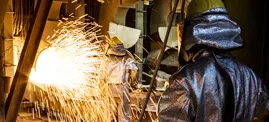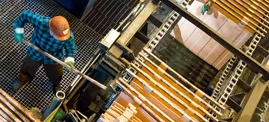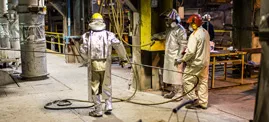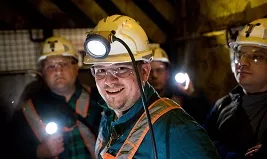PLN 10.1 billion in sales, PLN 1.2 billion in net profit – these results were achieved by the KGHM Group despite falling copper and silver prices, whilst maintaining stable production and cost discipline
During the first six months of 2015 the USD-denominated copper price decreased by 14 percent, while silver fell by 17 percent, compared to the first half of 2014.
The results of the KGHM Group were supported by the USD/PLN exchange rate. The lower dollar price of the red metal was largely offset by the weakening of the Polish zloty. Despite declines in metals prices, the average price of copper expressed in PLN was slightly higher than that recorded in the same period last year – Jarosław Romanowski, 1st Vice President of KGHM (Finance).
A similar effect was also seen in the case of the silver.
In the first half of 2015 copper equivalent production by the KGHM Group rose 2 percent. The increase occurred both in KGHM Polska Miedź SA as well as KGHM International, where the increase was mainly due to higher production by the Robinson mine.
KGHM maintained its cost discipline. The C1 unit cash cost in the Group fell by 3 percent as compared to the first half of 2014 in terms of prices and the exchange rate.
At the same time there was an increase in the volumes of copper and gold sold, which given a favourable exchange rate, resulted in sales 5 percent higher than in the same period of 2014.
Key investments both in Poland and abroad are being carried out as scheduled.
The Sierra Gorda mine commenced commercial production in June and is very close to achieving its target processing capacity. Our Victoria and Ajax projects in Canada and the Deep Głogów project in Poland are being developed as planned. We are also continuing to advance the Pyrometallurgy Modernisation Program - Herbert Wirth, President of the Management Board of KGHM.
Production of copper in concentrate in the Sierra Gorda mine in the first half of 2015 reached about 38,000 tonnes. In mid-April, the first molybdenum concentrate was produced, and in July design work began related to phase II of the mine’s development.
Work is under way at the Victoria project to prepare for shaft sinking. Work related to the preparation of surface infrastructure is also under way.
The Canadian regulator has approved the Application Information Requirements document, enabling application for an environmental permit for the Ajax mine.
Construction of the GG-1 shaft is being carried out as planned. The shaft is a critical element in mining the Deep Głogów deposit. At the end of the first half of 2015 the shaft had reached a depth of 563 metres (total target depth is 1340 metres, with a diameter of 7.5 meters).
Assembly and construction work continues on the main elements of the modernized flash furnace at the Głogów Copper Smelter and Refinery. 98 percent of the contracts for construction and assembly work have been signed. The launch of the installation is planned for the fourth quarter of 2016.
In June we presented the first edition of our Resources and Reserves Report, which consolidates and systemizes knowledge about the mineral resources and reserves controlled by the KGHM Group.
The report was prepared in accordance with the standards and definitions of the Canadian Institute of Mining, Metallurgy and Petroleum, as described in the document NI 43-101. Together with the Australian JORC standard, it serves as one of the two leading international standards for reporting resources and reserves.
The Resources and Reserves Report presents the state of our mineral resources and reserves as at 31 December 2014. The Report highlights the following figures:
- 22.7 million tonnes of copper in Proven and Probable ore reserves;
- 44.4 million tonnes of copper in Measured and Indicated mineral resources (this includes proven and probable reserves);
- 8.7 million tonnes of copper in the inferred category.
Volatility has recently been a key characteristic of the macroeconomic environment. Therefore, KGHM is carefully analyzing the potential threats and risks, under the assumption that copper and silver prices will potentially undergo further unfavorable moves.
The potential impact of these changes may require a revision of investment expenditures and a downward revision in the value of production assets. If the ratio of market cap to net assets were to remain below 0.8 over a long period (more than 12 months), the company would be required to review indications of, and test for, the impairment of assets.
KGHM is also analyzing the potential consequences of a further strengthening of the USD, which would put pressure on USD-denominated commodities prices. Also of potential significance is a more-than-anticipated slowdown of the Chinese economy, which could lead to a slowdown in the rate of growth of copper consumption.
As a result the company is reviewing its projects and investment programs, and assumes the possibility of a postponement of projects and the shelving of certain investments. We are analyzing scenarios in which there is a long-term continuation of prices at low levels. In full consideration of the factors which pose a threat to the achievement of the KGHM Group’s plans, the company is engaged in actions to weaken their negative impact.





